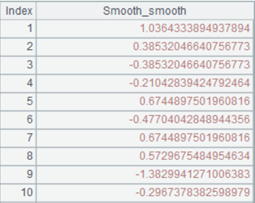A.smooth()
Description:
Perform smoothing on a sequence type variable during modeling.
Syntax:
|
A.smooth(T) |
During modeling, perform smoothing on high-frequency categorical enumerated variable A and return a binary sequence containing the smoothing result and the smoothing records Rec |
|
A.smooth@r(Rec) |
During scoring, perform smoothing on multiclassification enumerated variable A according to Rec, the smoothing process records, and return the smoothing result |
Note:
The external library function (See External Library Guide) performs smoothing on a sequence type variable during modeling.
Parameter:
|
A |
A sequence containing high-frequency categorical enumerated variables |
|
T |
A sequence of target variable values |
|
Rec |
A sequence of smoothing process records |
Option:
|
@c |
Modify the original data to the smoothing result after execution |
|
@bnie |
Each option specifies a target type, and options are mutual-exclusive; automatically judge the type when no option is used; the order of priorities of the options is binary, numeric, integer and enumerated |
Return value:
Sequence
Example:
|
|
A |
|
|
1 |
[a,d,f,g,y,j,y,k,l,v,x,,w,t,j,c,,z,h,y,j,e,e,s,d,q,ad,gr,hy,ki,lo,ss,df,afd,ju,li,ol] |
Input a sequence of high-frequency categorical variables. |
|
2 |
=A1.len().(rand(100)) |
Generate a sequence of integers of same length as A1. |
|
3 |
=A1.setenum@c() |
Map A1 as integers and modify the original data. |
|
4 |
=A1.smooth(A2) |
Take A2 as the target variable, perform smoothing on A1, and return smoothing result and smoothing process records Rec. |
|
5 |
=A1.smooth@r(A3(2)) |
Perform smoothing on A1 according to A3’s smoothing process records; often used to smooth the score data. |

